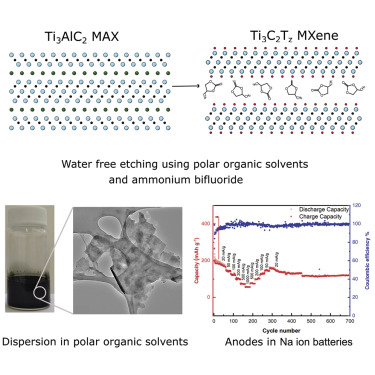Chem ( IF 19.1 ) Pub Date : 2020-02-24 , DOI: 10.1016/j.chempr.2020.01.019 Varun Natu , Rahul Pai , Maxim Sokol , Michael Carey , Vibha Kalra , Michel W. Barsoum

|
The first MXene discovered, Ti3C2Tz, was synthesized by etching of the parent MAX phase, Ti3AlC2, in a solution of concentrated hydrofluoric acid. Since then, several other ways of synthesizing MXenes have been reported, such as electrochemical etching in various electrolytes, high-temperature alkali treatment, molten salt synthesis, etc. The majority of these etching methods, however, use water as their main solvent, limiting direct use of MXenes in water-sensitive applications. In this work, we show that it is possible to etch, and delaminate, MXenes in the absence of water, by using organic polar solvents in the presence of ammonium dihydrogen fluoride. We further show that by using this etching method, it is possible to obtain Ti3C2Tz flakes rich in fluorine terminations. We also demonstrate that electrodes made from Ti3C2Tz etched in propylene carbonate resulted in Na-ion battery anodes with double the capacity to those etched in water.
中文翻译:

通过在极性有机溶剂中无水刻蚀Ti 3 AlC 2来合成2D Ti 3 C 2 T z MXene
通过蚀刻母体MAX相Ti 3 AlC 2合成了发现的第一个MXene Ti 3 C 2 T z。在浓氢氟酸溶液中。从那时起,已经报道了合成MXene的其他几种方法,例如在各种电解质中进行电化学蚀刻,高温碱处理,熔融盐合成等。但是,这些蚀刻方法大多数都以水为主要溶剂,因此在对水敏感的应用中直接使用MXene。在这项工作中,我们表明可以在不存在水的情况下,通过在氟化二氢铵中使用有机极性溶剂来腐蚀和分层MXene。我们进一步表明,通过使用这种蚀刻方法,可以获得富含氟末端的Ti 3 C 2 T z薄片。我们还演示了由Ti 3 C制成的电极在碳酸亚丙酯中蚀刻的2 T z导致Na-离子电池阳极的容量是在水中蚀刻的两倍。











































 京公网安备 11010802027423号
京公网安备 11010802027423号